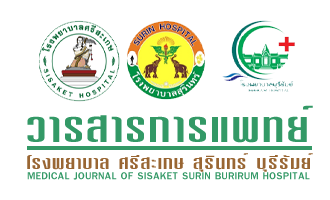โรคมะเร็งเม็ดเลือดขาวเฉียบพลันชนิดมัยอิลอยด์ ในโรงพยาบาลสุรินทร์
Main Article Content
บทคัดย่อ
หลักการและเหตุผล: โรคมะเร็งเม็ดเลือดขาวเฉียบพลันชนิดมัยอิลอยด์ acute myeloid leukemia (AML) เป็นโรคที่มีความรุนแรงมากผู้ป่วยจะเสียชีวิตทุกรายถ้าไม่รักษา โรงพยาบาลสุรินทร์เป็นโรงพยาบาลศูนย์ที่สามารถให้การรักษาผู้ป่วยโรคมะเร็งเม็ดเลือดขาว เฉียบพลันชนิดมัยอิลอยด์ได้ จึงทำการศึกษาและเก็บรวบรวมข้อมูลการรักษา และผลการรักษาผู้ป่วยในกลุ่มนี้
วัตถุประสงค์: เพื่อศึกษาผู้ป่วยโรคมะเร็งเม็ดเลือดขาวเฉียบพลันชนิดมัยสิลอยด์ในโรงพยาบาลสุรินทร์ ในด้านอายุ, เพศ, ชนิดของมะเร็งเม็ดเลือดขาว, โครโมโซม และผลการรักษาหลังได้ยาเคมีบำบัด induction chemotherapy เพื่อใช้เป็นข้อมูลพื้นฐาน และใช้เป็นแนวทางในการปรับปรุงการรักษาผู้ป่วยกลุ่มนี้ต่อไป
วิธีการศึกษา: ทบทวนเวชระเบียนผู้ป่วยโรคมะเร็งเม็ดเลือดขาวเฉียบพลันชนิดมัยสิลอยด์ที่ได้รับ การวินิจฉัยและเข้ารับการรักษาในโรงพยาบาลสุรินทร์ ตั้งแต่วันที่ 1 มกราคม พ.ศ. 2549 ถึงวันที่ 31 ธันวาคม พ.ศ. 2551 เพื่อศึกษาปัจจัยด้านอายุ, เพศ, ความผิดปกติของโครโมโซม, ชนิดของมะเร็งเม็ดเลือดขาว (FAB classification), การเข้าสู่ภาวะปกติของไขกระดูก complete remission (CR) หลังได้ยาเคมีบำบัด induction chemotherapy โดยคำนวณเป็นร้อยละของผู้ป่วยทั้งหมด
ผลการศึกษา: ผู้ป่วยโรคมะเร็งเม็ดเลือดขาวเฉียบพลันชนิดมัยสิลอยด์ มีจำนวน 21 ราย เป็น เพศชาย 47.6% เพศหญิง 53.4% อายุระหว่าง 15-60 ปี อายุเฉลี่ย 41.95 ปี ในด้านความผิดปกติของโครโมโซม พบว่าผู้ป่วยอยู่ในกลุ่มที่มีโครโมโซมดี, ปานกลาง, และไม่ดี 9.5%, 71.4% และ 19.1% ตามลำดับ ชนิดของมะเร็งเม็ดเลือดขาว แบ่งตาม FAB classification พบว่าผู้ป่วยส่วนใหญ่อยู่ในกลุ่ม Ml มีจำนวน 28.5% ตามด้วย M2, M3, M4, MO, M5, M6, และ M7จำนวน 14.3%, 14.3%, 14.3%, 9.5%, 9.5%, 4.8% และ 4.8% ตามลำดับ ส่วนผลการรักษาหลังได้ยาเคมีบำบัด Induction chemotherapy พบว่าผู้ป่วยเข้าสู่ภาวะปกติของไขกระดูก complete remission 66.6%, ไม่เข้าสู่ภาวะ complete remission 19.0% และเสียชีวิต 14.3% โดยผู้ป่วยเสียชีวิตจากการติดเชื้อทั้งหมด
สรุป: จากการศึกษานี้พบว่าผู้ป่วยโรคมะเร็งเม็ดเลือดขาวเฉียบพลันชนิดมัยสิลอยด์ (AML) ในโรงพยาบาลสุรินทร์ได้รับ CR rate หลังยาเคมีบำบัด 66.6% แต่มี อัตราเสียชีวิต 14.3% ส่วนใหญ่เกิดจากภาวะเม็ดเลือดขาวตาและมีการติดเชื้อ แทรกซ้อน ดังนั้นการให้ยาเคมีบำบัดที่เหมาะสมและมีการควบคุมภาวะการติดเชื้อให้มีประสิทธิภาพมากยิ่งขึ้นเพื่อช่วยลดอัตราการเสียชีวิต และอาจเพิ่ม CR rate ได้มากขึ้นด้วย
คำสำคัญ: โรคมะเร็งเม็ดเลือดขาวเฉียบพลันชนิดมัยสิลอยด์, การเข้าสู่ภาวะปกติของไขกระดูก
Article Details
เอกสารอ้างอิง
Silverberg E, Lubera JA. Cancer statisties. CA 1989; 39:3-20.
Champlin R Gale RP. Acute myelogenous leukaemia : recent advances in therapy. Blood 1987;69:1551-62.
Stein RS. Review : Advances in therapy of acute nonlymphogenic leukaemia. Am J Med Sci 1989; 297:26-34.
Bennett JM, Catovsky D, Daniel MT, et al. Proposals for the classification of the acute leukaemia (FAB co-operative group). Br J Hematol 1976;33:451-8.
Bennett JM, Catovsky D, Daniel MT, et al. Proposed revised criteria for classification of acute myeloid leukemia. Ann totem Med 1985;103:620-9.
Lowenberg B, Downing JR Burnett A. Acute myeloid leukemia. N Engl J Med 1999; 341: 1051-62.
Giles FJ, Keating A, Goldstone AH, Avivi I, Willman CL, Kantarjian HM. Acute myeloid leukemia. In : Hematology 2002. Washington, DC: American Society of Hematology 2002: 73-110.
Slovak ML, Kopecky KJ, Cassileth PA. et aL Karyotypic analysis predicts outcome of preremission and postremission therapy in acute myeloid leukemia: a Southwest Oncology Group/Eastern Oncology Group study. Blood 2000;96:4075-83.
Mrozek K, Heinonen K, dela Cahapelle A, Bloomfield CD. Clinical Significance of Cytogenetics in Acute Myeloid Leukemia. Seminars in Oncology 1997;24: 17-31.
Grimwade D., Walker H, Oliver F. et al. The Important of Diagnostic Cytogenetics on Outcome in AML: Analysis of 1,612 Patients Entered Into The MRC AML 10 Trail. Blood 1998:92: 2322-33.
Cheryl LW. Molecular Evaluation of Acute Myeloid Leukemia. Seminars in Hematology 1999;36: 390-400.
Grier HE, Gelber RD, Camitta BM, et al. Prognostic Factor in Childhood Acute Myeloid Luekemia. Journal of Clinical Oncology 1987;5:1026-32.
Delmer B, Jean-Pierre M Danielle T. et al. Multivariate Analysis of Prognostic Factors in Acute "Myeloid Leukemia.: Value of Clonogenic Leukemia Cell Properties. Journal of Clinical Oncology 1998;7:738-46.
Adida C, Recher C, Raffoux E, et al. Expression and prognostic significance of surviving in de novo acute myeloid leukemia. British Journal of Haematology 2000;111:196-203.
Byrd JC, Mrozek K, Dorge RK, et al. Pre-treatment cytogenetic abnormalities are predictive of induction success, cumulative incidence of relapse, and overall survival in adult patients with de novo acute myeloid leukemia: results from Cancer and Leukemia Group B (CALGB 8461). Blood 2002;100:4325-36.
Bishop JF, Matthews JP, Young GA, et al. A Randomized Study of High-Dose Cytarabine in Induction in Acute Myeloid Luekemia. Blood 1996;87:1710-7.
Yate JW, Glidewell O, Wiemik PH, et al. Cytosine Arabinoside With Daunorubicin or Adriamycin for Therapy of Acute Myelocytic Leukemia : A CALGB Study! Blood 1982;60:454-62.
Archimbaud E, Jehn U, Thomas X, et al. Multicenter randomized phase n trial of idarubicin vs mitoxantrone, combined with VP-16 and cytarabine for induction/ consolidation therapy, followed by a feasibility study of autologous peripheral blood stem cell transplantation in elderly patients with acute myeloid leukemia. Leukemia 1999;13:843-9.
Vogler WR Velez-Garcia E, Wliner RS, et al. A phase in trial comparing idarubicin and daunorubicin in acute myelogenous leukaemia : a Southern Cancer Study Group studys. J Clin Oncol 1992;10:1103-11.
Wiemik PH, Banks PLC, Case PC Jr. et al. Cytarabine plus Idarubicin or Daunorubicin as Induction and Consolidation Therapy for Previously Untreated Adult Patients With Acute Myeloid Leukemia. Blood 1992;79:313-9.
Arlin Z, Case DC J. Moore J, et al. Randomized multicenter trial of cytosine arabinoside with mitoxantrone or daunorubicin in previously untreated adult patients with acute nonlymphocytic leukemia (ANLL). Leukemia 1990;4:177-83.
Lowenberg B, Suciu S, Archimbaud E, et al. Mitoxantrone versus Daunorubicin in Induction-Consolidation Chemotherapy-The Value of Low-Dose Cyarabine for Maintenance of Remission, and an Assessment of Prognostic Factors in Acute Myeloid Leukemia in the Elderly : Final Report of the Leukemia Cooperative Group of the European Organnization for the Reseach and Treatment of Cancer and the Dutch-Belgian Hemato-Oncology Cooperative Hovon Group Randomized Phase III Study AML-9. Journal of clinical Oncology 1998;16:872-81.
Giamarellou H, Antoniadou A. Infectious complications of febrile leukopenia. Infect Dis Clinics of N. Am. 2001;15:457-82.
Donowitz GR, Maki DG, Cmich CJ, et al. Infections in the Neutropenic Patient-New Views of an Old Problem. In : Hematology 2001. Washington, DC: American Society of Hematology 2001:113-39.
ชุษณะ สวนกระต่าย. ภาวะไข้และเม็ดเลือดขาวต่ำ. ใน : พรรณทิพย์ ฉายากุล, ชิษณุ พันธุ์เจริญ และคณะ, บรรณาธิการ. ตำราโรคติดเชื้อ. กรุงเทพฯ : โฮลิสติก ; 2548 : 1008-73.


